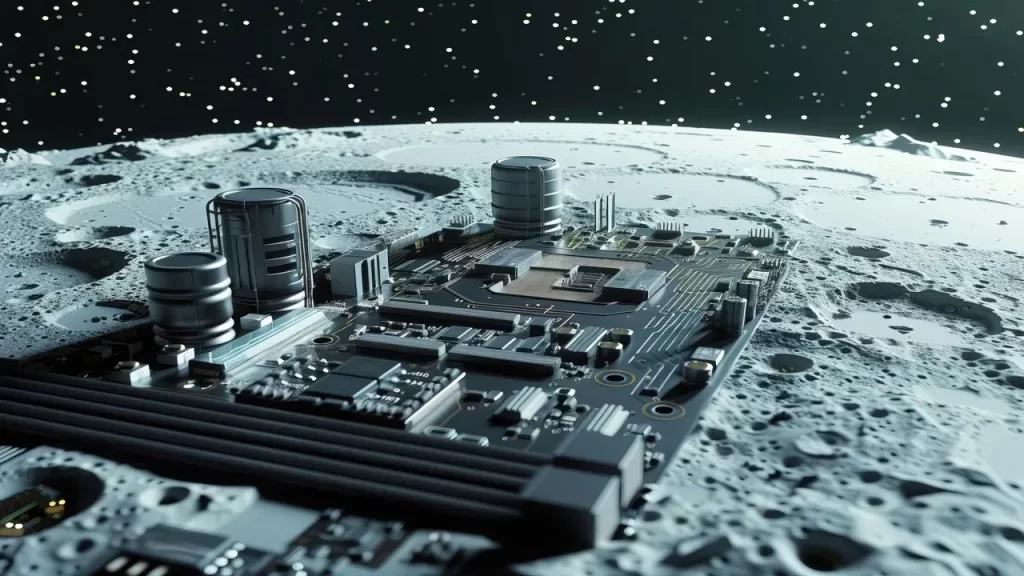Lonestar Data Holdings is at the forefront of the proposal to take data centers to other planets, beginning with a mini 1-kilogram 8-terabyte data center delivered into space by SpaceX Falcon 9. If it is to be taken off the planet, the idea is to safeguard data from Earth-based threats such as natural catastrophes, warfare, and cyberterrorism which sets a new standard of protection and reliability.
Plans include building larger data centers in the Moon’s cold regions and placing others at stable Lagrange points in orbit. These locations offer constant temperatures and solar access reducing cooling costs and supporting renewable energy. The move could also bypass data sovereignty laws, enabling global data hosting from space.
Moon-Based Data Centers: The Next Frontier in Digital Infrastructure
Elon Musk’s SpaceX gears up for February 26 to launch a Falcon 9 rocket carrying the Intuitive Machines lander to the Moon. Included amongst its cargo is a micro data center weighing less than 1kg and containing 8 TB of SSD storage provided by Lonestar Data Holdings. This particular mission has laid some groundwork on the process required to construct data centers on the surface of the moon, bringing a possibility of major progress in the protection and storage of data.
Though it appears to be the plot of a sci-fi movie, it has arisen due to the actual need to solve real-life problems relating to data reliability, location, and permanence. Here is a breakdown of why cloud companies are pushed to make that lunar leap and the benefits and drawbacks that are expected out of this strategy.
The Case for Lunar Resilience
On Earth, data centers are vulnerable to natural disasters, war, and infrastructure failures like undersea cable cuts. Lonestar CEO Christopher Stott calls lunar storage “resilience as a service,” offering a level of redundancy that’s untouched by earthly hazards. The Moon’s predictable environment lacking atmosphere, storms, or tectonic activity presents a stable alternative for critical data storage.
This stability is particularly appealing to governments and organizations seeking to preserve mission-critical or culturally significant data. In this mission, Florida’s state government and the Isle of Man are already testing the waters. Even Bethesda’s video game Starfield and Imagine Dragons’ “Children of the Sky” are hitching a ride, highlighting the mission’s broad appeal and symbolic relevance.
Sovereignty Beyond Borders
The concept of data sovereignty across different countries around the world means that the information has to be stored within certain geographical boundaries. Now imagine if your data center is not even located on Earth. The Moon is legally making space law available and was deliberately made so by the United Nations OST, which did not allow national appropriation. This makes a lunar data center half fictitious and half real in a way that it can accommodate many black-box systems with their own set of data laws.
In essence, this sidesteps the limitations of terrestrial borders, making the Moon an ideal neutral zone for multinational cloud infrastructure. If achieved, this may radically transform the way that private enterprises and governments of the world come to adhere to the rule of law/offer data hosting services.
Cooler, Cleaner, and More Efficient
The moon has native low temperatures, about as low as -173 Celsius in the craters that are in perpetual shade, and the decrease of temperature is exponential towards the poles. Aerogel can provide comfortable temperatures to the current earth-based infrastructures despite consuming very little energy in this process. On the Moon, such components would not be required, and electrical resistance in the circuits will be less, and therefore the performance of the circuits will increase.
Additionally, solar energy could power lunar data centers sustainably. While the data centers themselves would be buried in craters for thermal insulation nearby crater rims enjoy near-continuous sunlight. Energy harvested there could be transmitted efficiently, creating a green, self-sustaining infrastructure.
Latency and Maintenance Hurdles
One of the Moon’s biggest drawbacks is distance. Data sent to and from Earth faces a minimum 1.4-second delay, ruling out real-time applications like live gaming, autonomous driving, or high-frequency trading. However, workloads like AI training, archival storage, and image processing could be handled without issue, according to experts like IREN’s Kent Draper.
Another challenge is maintenance. Earth-bound data centers rely on 24/7 on-site teams. The Moon, of course, offers no such luxury. Lonestar plans to mitigate this with redundancy, automation, and rigorous Earth-based testing. Still, managing server configuration and responding to failures remotely is a complex problem yet to be solved.
A Future Written in Lunar Dust
Nevertheless, Lonestar has set its sights forward, as we have seen from the above information. Upcoming missions are to place data centers at the L1 and L2 points, lunar far side, and in extinct lava tubes that have a stable temperature of about -20°C inside. The locations could help accommodate large-scale, secure, and efficient data centers for the universities’ uses.
As the race to return to the Moon intensifies, moon-based data centers could become a driving force for space tech. Experts like Texas A&M’s Reza Nekovei believe that if this mission proves viable, the lunar cloud could be the next trillion-dollar industry, changing not only how we store data but also where the future of tech will be built.








